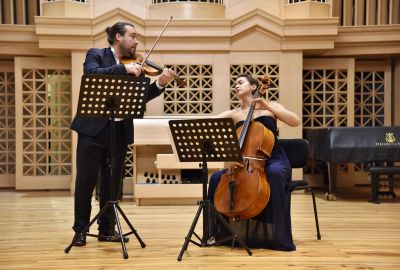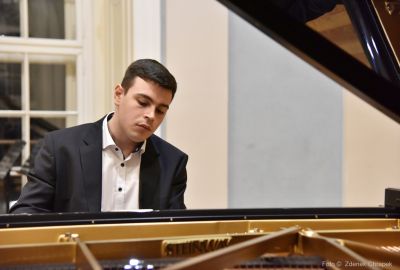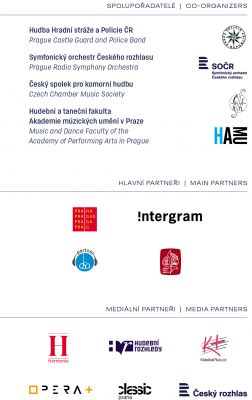WE
Bohuslav Martinů Days 2020 | Laureates of the Bohuslav Martinů Foundation Competition 2019


9. 12. 2019
Concert of laureates of the BMF Competition 2019
Antonín Dvořák /1841 – 1904/
Furiants for Piano, Op. 42
Furiant No. 1 in D major – Allegro con fuoco
Furiant No. 2 in F major – Allegro con fuoco
Bohuslav Martinů /1890 – 1959/
Eight Preludes H 181
1.En forme de Blues. Poco andante; 2. En forme de Scherzo. Vivo; 3. En formed`Andante. Adagio; 4. En forme de Danse. Allegro vivo; 5. En forme de Capriccio. Allegretto; 6. En forme de Largo. Lento; 7. En formed`Etude. Presto; 8. En forme de Fox-Trot. Allegro
Luboš Sluka /1928/
Sonata per pianoforte
Bohuslav Martinů
Duo for Violin and Cello No. 2 H 371
Allegretto–Adagio–Poco allegro
Maurice Ravel /1875 – 1937/
Sonata for Violin and Cello
Allégro–Trèsvif–Lent–Vif, avecentrain
Matouš Zukal piano, String duo Bohémo / Kristina Vocetková cello, MatoušPěruška violin /
A WORD ON THE PROGRAMME
Furiants, Op. 42 are from the so-called Slavonic period of Antonín Dvořák. The composer
wrote them in June and September 1878 and dedicated them to the pianist Karel
Sladkovský, who was also the first to perform them. The highly virtuosic works were
premiered in Prague on 17 November 1878. However, they are not typical furiants, like the
ones Dvořák created in Slavonic Dances, for example, but rather, they are free-flowing
fantasies in the spirit of Czech folk music.
Bohuslav Martinů had always admired French art. Although his state scholarship allowed
him to study under Albert Roussel, the Paris music scene of the 1920s was no longer partial
to the music of Debussy or Impressionism that had enticed the young composer there – the
great city was awash with Les Six, jazz, Stravinsky… Eight Preludes for Piano, H 181, were
composed by Martinů in 1929 and dedicated to “Mademoiselle Charlotte Quennehen” – the
lady who became his wife two years later. Some of the preludes are titled with fashionable
dances of the time – blues, foxtrot – but all of them are influenced and shaped by jazz, as it
was perceived and absorbed by European musicians who welcomed the wondrously exotic
style to the old continent.
Luboš Sluka is one of the doyens of Czech music. His oeuvre encompasses a broad array
of genres and is vastly expansive and essentially Czech. Sonata for Piano from 1988 was
written as a tribute to Sluk’s friend and classmate from the Music Academy, the excellent
pianist Antonín Jemelík (1930–1962), who was murdered by Czechoslovak State Security
and the secret police at the mere age of 32. His art is testified to by only a few privately held
recordings, the testimonies of those who knew him, and the dedications of prominent
composers, who admired him (such as Luboš Fišer and Klement Slavický). The onemovement sonata is opened by a four-bar Grave, which transforms into a dramatically
contrasted Appassionato. The subsequent Allegro ritmico follows attaca, ushering in a hint of
jazz and variable time signatures. The work was first performed by Aleš Bílek in Prague on
27 March 1991.
Duo for Violin and Violoncello No. 2, H 371, is one of Bohuslav Martinů’s late works,
composed in just four days (28 June to 1 July 1959) during his penultimate summer, which
he spent with the Sachers in Schönenberg, Switzerland. The composition was commissioned
by the eminent Basel musicologist Dr Ernst Mohr on the occasion of the 50th birthday of his
wife – to whom the piece is dedicated – “Dédié à Madame Trauti Mohr-Bally”. The Duo
displays the typical attributes of Martinů’s late Neoclassical output with its stylistic and
harmonic peculiarities, and it is graceful and entertaining – although a nostalgic yearning for
Martinů’s homeland does appear in glimpses especially in the final section. The composition
was given a private premiere after the composer’s death, in Basel on 4 March 1962,
performed by the violinist Hansheinz Schneeberger and the cellist Dieler Stählin.
In 1920 the publisher Durand asked Maurice Ravel to write something for the special issue
of La Revue Musicale, devoted to Claude Debussy. The magazine’s supplement included the
first movement of Ravel’s Sonata for Violin and Cello, alongside other works provided by
Debussy’s friends. This first movement then gave rise to a richly developed composition with
four movements, in which the composer explored completely new means of expression:
utilising quartal and quintal harmonies, abrupt dissonance, or bitonality. The Sonata, which
was composed between 1920 and 1922, was premiered on 6 April 1922 by Hélène JourdanMorhange (violin) and Maurice Maréchal (violoncello). The critics labelled the performance a
“massacre” because they assumed (perhaps quite understandably) that the musicians were
playing the wrong notes. Ravel described the Sonata as a turning point in his musical
development.
THE MUSICIANS
Matouš Zukal
started playing the piano when he was seven. He studied under Jitka
Němcová at the Grammar and Music School of the Capital City of Prague and in the class of
Ivo Kahánek at the Prague Conservatoire. He is currently continuing his education under the
same professor at the Academy of Performing Arts in Prague. He has won a number of
major awards in piano competitions, among others, Virtuosi per musica di pianoforte, the
Broumov Keyboard, or the Competition Festival of Conservatoire and Music Grammar
Schools. He is a laureate of the Young Piano of the Prague Conservatoire from 2011, 2013,
and 2015. In 2019 he earned first place and Best Contestant Award in the Bohuslav Martinů
Foundation Competition. He has also been awarded a scholarship at the Chamber Music
Academy, and he performs at chamber concerts organised by the institution. He participates
in masterclasses and consults with prominent international teachers (M. Chernyavskaya, A.
Kouyoumdjian, M. Schirmer, and others). In 2016, 2018, and 2019 he attended
masterclasses in Bergen, Norway, under the guidance of Prof. Jiří Hlinka, Leif Ove Andsnes,
and other eminent pianists.
Duo Bohémo – Kristina Vocetková and Matouš Pěruška
have been chamber partners since
their student days at the Prague Conservatoire. They are currently studying chamber music
in a postgraduate programme at the Ferenc Liszt Academy in Budapest under the guidance
of Prof. Mezö Péter. They are both laureates of international contests who regularly perform
at home and abroad. As a duo, they won the Bohuslav Martinů Award and the Zoltán Kodály
Award in Austria in 2015. Two months later they became the overall winners of the Karl
Ditters von Dittersdorf Chamber Ensemble Competition. In May 2016 they triumphed at the
Concorso musicale citta di Filadelfia “Paolo Serrao” in Filadelfia, Italy. In 2018 they took to
the stage at the EuroArt Festival, the Antonín Dvořák Music Festival, or the International
Music Festival Kutná Hora. In 2019 they toured Austria for the ISA Festival and for a grand
concert at Vienna’s ORF. In November 2019 they won the Bohuslav Martinů Foundation
Competition, earning recognition for the Best Performance of a Work by Bohuslav Martinů
and for being the Best Participants in the Category of Chamber Ensemble Without Piano.
They are regularly invited to collaborate with larger chamber ensembles. In the past they
have performed alongside the likes of Miklós Perényi, Markus Shirmer, Magda Amara, Hagai
Shaham, Gilad Karni, or Jiří Bárta.

